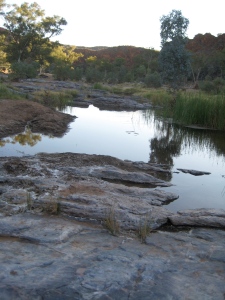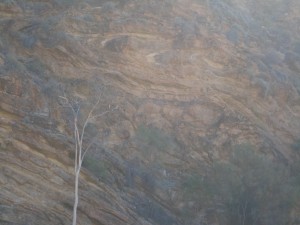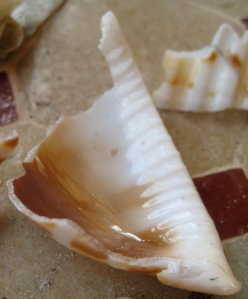
Sunset on the pools at Ruby Gorge, NT
A year ago, an article appeared in the Sydney Morning Herald about a creative camp, run by a naturalist and an award-winning artist, in a stunning setting several hours outside Alice Springs in the Red Center of Australia. The reports were glowing. A friend asked if I’d seen the article. Was I keen to go? She’s a hoot — wonderfully innovative and creative. With her along, it couldn’t be other than lots of fun. We signed up.
In the intervening year, economies shrank, but the creative camp still loomed large. What bliss it would be to just think about art for a week, to do art for a week, to be fed and taught and organized, to enjoy the company of other artists in an exceptional setting.
I tried to keep my mind open and free of expectations, but I realize in retrospect, that I did harbor some, hidden in the far reaches of my psyche and formed from experiences over 15 years getting to know some wonderful Australians.
I expected to meet some interesting charismatic people. I did. The campers were a fantastic lot — funny, engaging, talented, with life-experiences worth sharing. If we hadn’t been admonished not to talk about our life-experiences other than at Ruby Gap, we might have learned more, engaged more. I learned heaps from each of them, though, and couldn’t have been more delighted to be in their company.
I expected the landscape to be fascinating. It was amazing. Folds and ribbons, layers and tilts, determined plants in the face of extreme drought and momentary flood. Wind-prints and footprints in the sand and sudden pools and reeds in a dry river. Last tides frozen in rock and ghost gums rising from rock in solitary cool defiance.

Ghost gum with Bitter Springs Dolomite
I expected the camp leaders to enjoy people. If you aren’t fascinated by people and their stories, their talents, and hope to learn as much from them as they learn from you, why operate a hospitality-based business?
Not only were our hosts clearly not interested in those who attended camp, their mercurial and irritated posture indicated that they wanted to be left alone, free from the demands we might inadvertently make on them.
I found this such a curious long-term posture, because in reality, those, like us, who participated in such adventures become the marketing voices of the camp’s future. If the owners didn’t naturally enjoy people and want to engage with them, at least, in their own self-interest, they should have faked it. It was a gig, after all.
I expected the hosts to be cordial, not moody, angry nor charismatically challenged. Their personalities set the tone for the camp and colored each day. None of us was spared a jab or disparaging remark over the course of a week in the desert.
Sharp, impatient, derisive, and sometimes profane retorts became the norm from our camp leaders. It doesn’t take much to keep people away. Steering clear? You bet! By day three, each artist retreated, wary and remote. By day six, we’d rallied again and so had they, but the damage was done. Opportunities and possibilities lost like puffs of smoke. Gone. Done.
I expected the leaders to have organized our time — a hike in the morning before tea, perhaps, and a tactic or still-life or master class after lunch. We did have 3 hikes in 7 days, to be accurate.
And, true, we did have a three techniques demonstrated. The first, oil pastels and water-based media, resulted in a temper tantrum from the owner about returning 150 pastels to precisely the same boxes in the same order they’d arrived in. The joy of exploration quickly evaporated as people struggled to find the correct combinations and then drifted away from the atmospherics.

Algae in pools on the Hale, Ruby Gap
I expected that there would be enough art materials for everyone to explore the techniques presented, although most of us brought what we wanted to work with. We were often told that there were not enough art supplies for everyone to participate. I wondered if they weren’t expecting 8 people? What did they have in mind?
Our first day in camp, our creative camp leader showed us the art materials and their place in the storage bin. She pulled out prayer flags created and hung around camp by a previous group and searched for her favorite. There were three blank flags and eight of us, so the group flag exercise was limited to three “if we wanted to.”
This turned out to be a theme: supplies were limited, but we could do it “if we wanted to.” We could do anything with the art materials if we wanted to, but if we asked to explore one technique or another, the tone of the response was irritation. The good will and hopes of the camp ebbed with each push/pull of invitation and irritation.
The art bin was stored between camps. “We don’t look at it between camps.” As we had dug the last of the glue out of the last two glue sticks, the next two camps were out of glue-luck. But they could “do whatever they wanted to” — except glue things together with glue-sticks, make prayer flags, use good paper, make lino-prints. Because there won’t be enough for everyone.
We began to work in pods, nurturing and caring for each other, avoiding the hosts. I walked and drew each day, returning for tea. Except for the meals, our hosts became peripheral. Who wants to engage with people who treat you as if you are misbehaving school children?

Ruby Gap on the Hale River, NT
To be fair, there was a plus side. The logistics were well-organized. The vehicles were well-kept and their spaces and cavities creatively employed. Our swags were clean and comfortable. The meals were healthy and tasty. While we were chastised for drinking too much wine (and did any beer drinkers switch to wine? shame!), there was enough for 2 small glasses each night (and 2+ mugs for the hosts).
It’s not enough, though, to bring people to a remote place, to say “you can do whatever you want” but to be angry and combative if one asks to use certain materials, if one asks where something should be returned, if one asks a question or offers help.
I tried to greet each day without expectations and with joy, but I struggled to remain positive, to find that joy, to find the amusing incident. Defense and protection are at odds with openness and delight.
Over the weeks since my return, I’ve replayed the week. Could I have escaped from art camp gulag? Asked a ride from passing tourists? Why didn’t I? By day four, I considered asking to be returned to Alice Springs — a 4 hour drive in a high 4-wheel vehicle. I learned that others in previous camps had longed for escape too. All of us kept hoping that it would get better, that the hosts would redeem themselves, get a grip on their own issues and help reshape our — and their own — experiences.

Last tide metamorphosed
The “maybe’s” are legion: Maybe being the 6th camp of 8 scheduled meant the hosts were just too tired, too burned out, too over it. Solution? Cancel the camp and refund the money? Don’t schedule so many? Hire an art teacher who enjoys the gig and a naturalist who likes people? Maybe this group of people just didn’t fit the hosts expectations? Solution? Take a course updating your hospitality and management skills? Maybe, maybe, maybe.
Would I recommend Larapinta Creative Camp? How do you feel about charismatically challenged, mercurial leaders in a stunning landscape? Your call. Your $1550.















